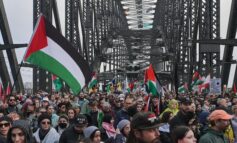
But most Palestinian resistance to the occupation is non-violent
Recent actions by Palestinians in Gaza seemed designed to expose bias in the American media. Last weekend, they organized a non-violent, symbolic protest at Gaza’s borders. Later in the week, Hamas began launching retaliatory rockets into Israel, killing one Israeli soldier and injuring many more, including a 70 year-old woman. Guess which story got more press in the United States?
A Google News search for “Gaza human chain” during the week after it took place turned up 246 articles, the vast majority of which were in foreign or alternative press. I also searched “Gaza rocket” for articles published within a day of a Hamas rocket killing an Israeli soldier on a college campus. More than 7,000 articles came up. Many of them, it should be noted, were about Israel’s response as well. Israeli forces killed 15 Palestinians in that 24 hour period.
A narrowed search including details about the rocket attack, such as the name of the town hit by the rockets, produced 3,000 articles.
This is not a scientific process, but it points to a vast difference in media interests. U.S. media are not that interested in story-lines that fall outside of the narrative of violent Palestinians — unless it is about the hyper-corrupt, shamelessly unrepresentative PA leaders seeking “liberation” through negotiations with Israel. This is a problem, since the vast majority of Palestinians resist in non-violent ways.
Media are so beholden to this image of the PA as a negotiating partner, that any other story is sure to get less attention. But in fact a recent poll has found that Israeli public opinion simply does not match the government’s line, nor the media’s understanding, of Hamas.
According to the survey, sixty-four percent of Israelis say the government must hold direct talks with the Hamas government in Gaza. They think negotiating a cease-fire and the release of captive soldier Gilad Shalit, both of which Hamas has proposed negotiating, should be on the table. This poll also found that forty eight percent of the respondents who are members of the Likud party, a conservative party, agreed. Yet, the United States rejects the idea out of hand.
Last weekend, more than 5,000 Gazans formed a human chain that stretched for more than 40 kilometers from Rafah in the south of the Strip to Beit Hanoun in the north.
The demonstrators hoped to “urge the international community to put more pressure on the Israelis to end the siege of Gaza,” according to Ramy, a spokesman for the Popular Committee Against the Siege, which organized the human chain in Gaza. He said that “Life here is getting worse. People are suffering and we are asking Israel and the international community not to push us to the breaking point.”
He also said that the protest was not organized by Hamas, despite media reports to the contrary. Some say moderate Hamas members were behind it. Eyad Sarraj, a psychiatrist and peace activist from Gaza, said “It’s paradoxical that this is coming from Hamas, the people who are really militant in their way of looking at resistance.”
Whether or not Hamas was behind the protest, some speculated it would have turned into a border crossing on par with last month’s mass influx into Egypt. Not enough people turned out to do that, in any case.
Both cases of violent and non-violent resistance are driven by desperation of the Palestinians of Gaza, a place wrecked by an Israeli embargo and nearly four decades of Israeli occupation. American media tend to cover violent actions more. This has to do both with the media’s general preference for covering spectacles and violence, but also with its large-scale ignorance of the Palestinian experience. As the saying goes, “If it bleeds, it leads.”
American media do not encourage or discourage the tactics of a bombarded people or a group with little concern for PR. The reality on the ground dictates what they choose to do. American media coverage is important because it informs Americans as to what is happening there. If only the story of violent resistance is being told, it skews peoples’ understanding. And for a public whose opinion matters for foreign and military aid, this is a deadly ignorance.





Leave a Reply